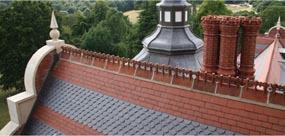Eaves and windows and vertical tiling
The following illustrations and text explain the common main tile design details that can occur on refurbishment and new work to eaves and windows.
Vertical tiling to eaves with soffit

The first counterbatten should be fixed approximately 20mm in front of the end of the batten to prevent the end nail from splitting the tile batten. The cut ends of the tile battens should be alternated to coincide with the short leg of the external angle tile.
Handed external angle tiles are laid alternately up an external corner
Each external angle tile should be twice nailed.
Avoid cutting the external angle tiles to make them fit.
Vertical tiling to window head V1
Set the eaves course above the window to allow the window to be installed or removed after the vertical tiling has been installed.
Set the gauge of the vertical tiling between the window sill and window head to eliminate the need for cutting the eaves course of tiles.
Fix a shaped timber tilting fillet to the face of the lintel (approximately 100 x 75mm) large enough to support the eaves course of tiles in the same plane as the rest of the vertical tiling.
Dress the underlay over the tilting fillet to a slight fall.
Terminate the counterbattens just below the eaves tile batten to allow the underlay to dress out over the tilting fillet.
Fix a minimum 6mm thick fire resistant board to the underside of the tilting fillet. Alternatively, cut plain tiles with their nibs removed could be used.
Vertical tiling to eaves with open rafter

The first counterbatten should be fixed approximately 20mm in front of the end of the batten to prevent the end nail from splitting the tile batten. The cut ends of the tile battens should be alternated to coincide with the short leg of the external angle tile.
Handed internal angle tiles are laid alternately up an internal corner.
Each internal angle tile should be twice nailed. Avoid cutting the internal angle tiles to make them fit.
Vertical tiling to window head V2
Set the eaves course above the window to allow the window to be installed or removed after the vertical tiling has been installed.
Set the gauge of the vertical tiling between the window sill and window head to eliminate the need for cutting the eaves course of tiles.
Fix a shaped timber tilting fillet to the face of the lintel (approximately 100 x 75mm) large enough to support the eaves course of tiles in the same plane as the rest of the vertical tiling.
Dress the underlay over the tilting fillet to a slight fall.
Terminate the counterbattens just below the eaves tile batten to allow the underlay to dress out over the tilting fillet.
Fix a minimum 6mm thick fire resistant board to the underside of the tilting fillet.
Vertical tiling to tiled window sill
Ensure that there is a suitable fall on the top surface of the double course of creasing tiles to allow water to run away from the window frame. A cut out in the external wall may be required.
Finish battens below the window opening to allow the top course of tiles to fit under the window sill.
Lay the creasing tiles broken bonded bedded on mortar (1:3 Cement:sand) using dentil slips as required. The creasing tiles should overhang the vertical tiling by 38 to 50 mm. Install the lead flashing (Code 4) into the mortar bed. Once the top tiles have been fixed the flashing can be carefully dressed onto the surface of the top tiles. When using a decorative flashing add the decorative section onto the coverage such that it does not compromise the lap relative to the vertical joint and the nail holes. The flashing should cover the top tiles by a minimum 100mm. If tops tiles are not used then the flashing should be extended to 150mm. It should extend a minimum of 150mm beyond the jamb on either side.
Vertical tiling to timber window sill V1
Finish battens approximately 10mm short of abutment wall to allow underlay to turn around the internal corner by 50mm.
Fix the first counterbatten approximately 20mm in from the end of the batten to prevent the end nail fixing from splitting the tile batten.
Fix a soaker, cut and folded from Code 3 lead sheet, minimum 200mm wide and 200mm long, to each course of tiles.
The bottom of the soaker should be flush with the bottom edge of the tile in the course above and the top should be folded over the head of the tile to prevent it dropping out.
Turn a cut and folded strip of Code 4 lead 1.5m long and approximately 100mm wide into the joints in the brick or block-work, covering the exposed ends of the soakers by approximately 50mm.
Vertical tiling to timber window sill V2

Finish battens below the window opening to allow the top course of tiles to fit under the window sill.
Nail the bottom edge of the lead flashing (minimum 200mm wide: Code 4) along the face of the top tile batten and dress it into the top tile nib space. Once the tops tiles have been fixed the flashing can be
carefully dressed onto the surface of the top tiles. When using a decorative flashing add the decorative section onto the coverage such that it does not compromise the lap relative to the vertical joint and the nail holes. The flashing should cover the top tiles by a minimum 100mm. If tops tiles are not used then the flashing should be extended to 150mm. It should extend a minimum of 150mm beyond the jamb on either side.
Vertical tiling eaves
Fix a shaped timber tilting fillet to the face of the lintel (approximately 100 x 75mm) large enough to support the eaves course of tiles in the same plane as the rest of the vertical tiling.
Dress the underlay over the tilting fillet to a slight fall. Terminate the counterbattens just below the eaves tile batten to allow the underlay to dress out over the tilting fillet.
Where there is a risk of fire entering the batten cavity fix a minimum 6mm thick fire resistant board to the underside of the tilting fillet.












-A.jpg)


